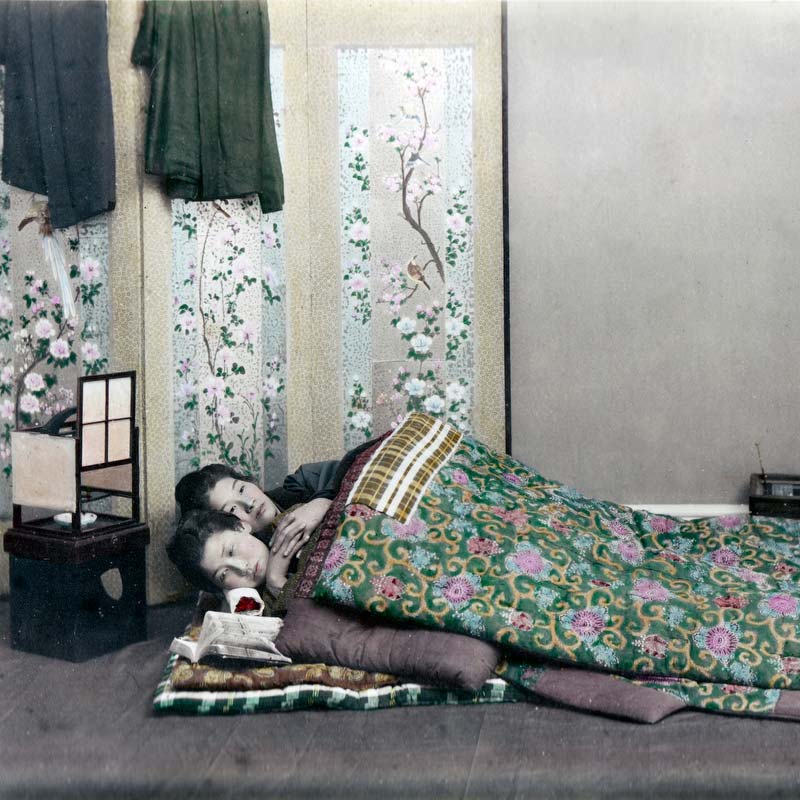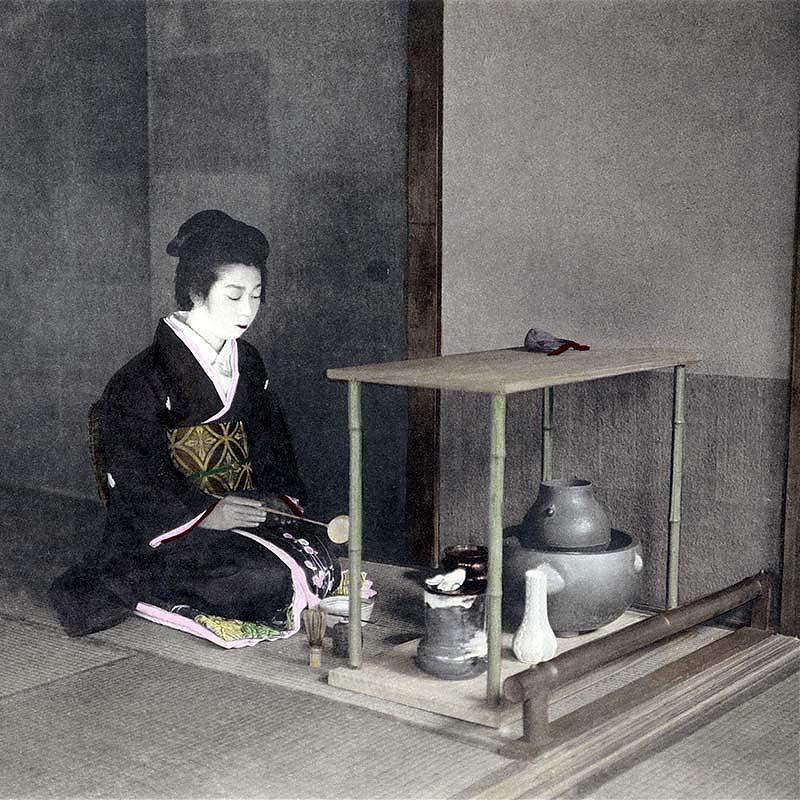Two women are squatting next to a bath in a beautiful wooden bathroom in Hakone, a famous onsen (spa) resort.
The windows feature artwork and the panels above them contain gorgeous displays of woodwork. A wooden ladle rests on the marble water pail in the left corner. This photo was taken by Kusakabe Kimbei, his reflection, and that of his camera, is visible above the two birds on the left window.

After Hakone, two other popular onsen resorts in eastern Japan during the Meiji period were Ikaho and Atami.
Few things are as integral to Japanese culture as bathing. To Japanese people it means far more than just staying clean, it is a ritual that ends the day, a way to relax, a form of entertainment, a way to communicate.
Japanese has even created a special expression, hadaka no tsukiai (裸の付き合い, naked relationship) to express the close and equal relationship of people sharing a bath completely in the nude.
The culture that has grown up around the scaldingly hot Japanese bath is extensive. There are baths inside homes, sento public baths and there is the wonderful and widespread custom of soaking in a hot spring.

During the Meiji Period (1868-1912), the Japanese obsession with the bath invariable surprised visitors from abroad, who often commented on it in books and diaries, usually in glowing terms.
“A Japanese crowd,” wrote British Japanologist Basil Hall Chamberlain in 1890 (Meiji 23), “is the sweetest in the world. The charm of the Japanese system of hot bathing is proved by the fact that almost all the foreigners resident in the country adopt it.”1
But foreigners did occasionally have trouble understanding, as Chamberlain shows in a later passage2:
The national passion for bathing leads all classes to make extensive use of the hot mineral springs in which their volcano-studded land abounds. Sometimes they carry their enjoyment of this simple luxury to an almost incredible extreme. At Kawara-yu, a tiny spa not far from Ikao in the province of Joshu—one of those places, of which there are many in Japan, which look as if they were at the very end of the world, so steep are the mountains shutting them in on every side—the bathers stay in the water for a month on end, with a stone on their lap to prevent them from floating in their sleep. When we were there some years ago, the care-taker of the establishment, a hale old man of eighty, used to stay in the bath during the entire winter. To be sure, the water is, in this particular case, one or two degrees below blood-heat. Thus alone is so strange a life rendered possible. In another case, some of the inhabitants of a certain village famed for its hot springs excused themselves to the present writer for their dirtiness during the busy summer months: “For,” said they, “we have only time to bathe twice a day.” “How often, then, do you bathe in winter?” “Oh! about four or five times daily. The children get into the bath whenever they feel cold.”
The custom was not unaffected by the Meiji Revolution. Mixed bathing, which had been a common and completely natural aspect of Japanese life, was seen as a sin by the prude Westerners of the time.
The Japanese authorities, eager to show that Japan was as “civilized” as the West, decided to outlaw it. Tokyo banned it as early as 1869 (Meiji 2). Apparently unsuccessfully, as it was banned again in 1870 (Meiji 3) and 1872 (Meiji 5).4 But eventually, the authorities did succeed.
These days, mixed bathing is quite rare and mostly limited to remotely located onsen.
Thankfully, the bath does still play a major role today as can be seen in the countless TV shows and magazine articles devoted to onsen resorts.
Although the daily bath may not surprise newly arrived visitors today as much as it did in Chamberlain’s time, one aspect that he mentioned does still surprise many3:
Strangest of all, after a bath the Japanese dry themselves with a damp towel!
Notes
1 Chamberlain, Basil Hall (1905). Things Japanese Being Notes on Various Subjects Connected with Japan for the Use of Travellers and Others. J. Murray: 61.
2 ibid.: 61-62.
3 ibid.: 482.
4 Seidensticker, Edward (1983). Low City, High City. Tokyo from Edo to the Earthquake: How the Shogun’s ancient Capital became a Great Modern City, 1867-1923. Alfred A. Knopf: 92.
Published
Updated
Reader Supported
Old Photos of Japan aims to be your personal museum for Japan's visual heritage and to bring the experiences of everyday life in old Japan to you.
To enhance our understanding of Japanese culture and society I track down, acquire, archive, and research images of everyday life, and give them context.
I share what I have found for free on this site, without ads or selling your data.
Your support helps me to continue doing so, and ensures that this exceptional visual heritage will not be lost and forgotten.
Thank you,
Kjeld Duits
Reference for Citations
Duits, Kjeld (). Hakone 1880s: Two Women in Bathroom, OLD PHOTOS of JAPAN. Retrieved on December 12, 2025 (GMT) from https://www.oldphotosjapan.com/photos/220/two-women-in-bathroom




Jessica
Beautiful!
#000057 ·
Kjeld Duits (Author)
I think so, too, Jessica. Thanks.
#000067 ·
chaser48
“”“The custom was not unaffected by the Meiji Revolution. Mixed bathing, which had been a common and completely natural aspect of Japanese life, was seen as a sin by the prude Westerners of the time.”“”
I am surprised that no one in what is proportedly a “global” society does not see that it is of no business whatsoever whether Chamberlain or the rest of the world felt about mixed bathing. Whose business is it other than the Japanese? I am an American and I experience the onsen culture as often as I can — They are the most civil of all societies and need not the approval rating from America or Europe this is for sure. It is stupid to separate the sexes one from another unless of course they prefer it fromo time to time — this is my sense
#000143 ·
Kjeld Duits (Author)
I totally agree with you, chaser48. Unfortunately, the Western powers had forced unequal treaties on Japan and Japan did everything it could to make itself civilized in the eyes of these powers in the conviction that the treaties would then be rescinded. Ironically, Japan wasn’t considered civilized by the Western powers until it had a war machine that equaled their own… I have a page from a British newspaper of the late 1800s that shows how the Japanese army has evolved. The article clearly says that Japan is now civilized because of its modern and strong army and navy. Such were the values and thoughts of the time.
#000145 ·
Rob Oechsle
Nice catch on the window refection !
#000584 ·
Kjeld Duits (Author)
@Rob: Hi, Rob. Great to hear from you again. Cool, eh! I wonder if Kimbei himself was aware of his reflection on the window.
#000585 ·